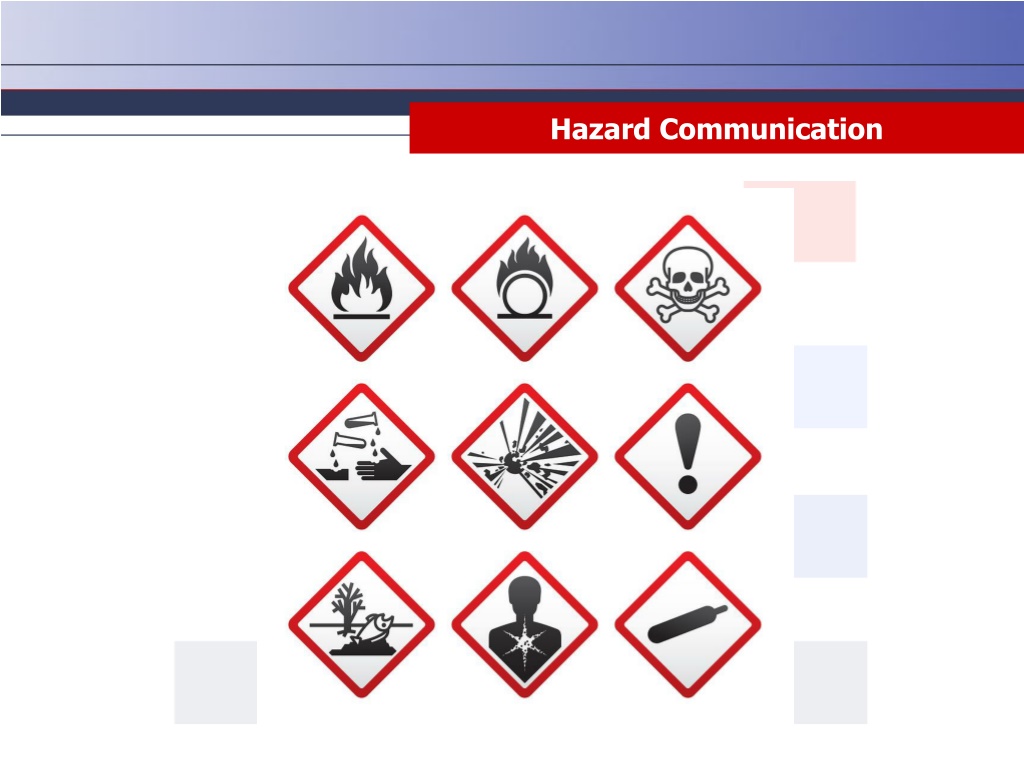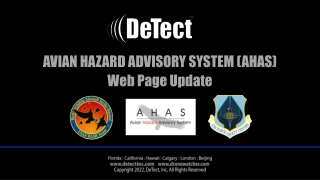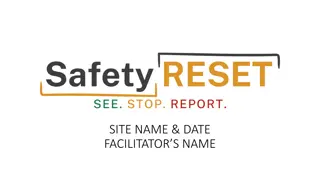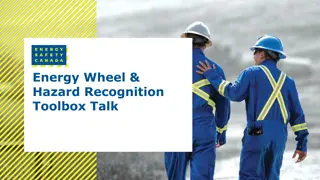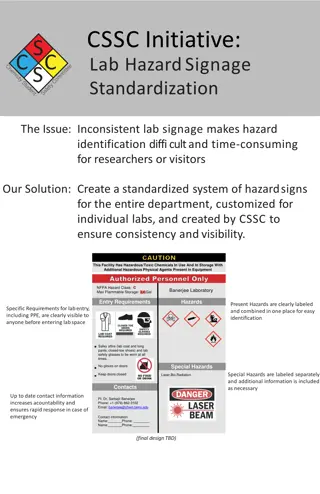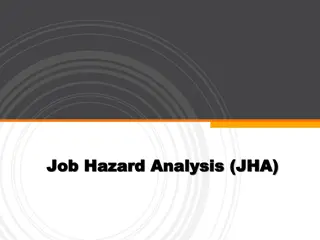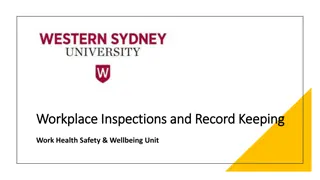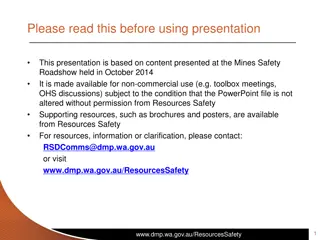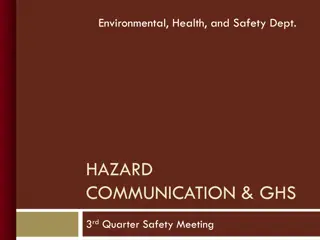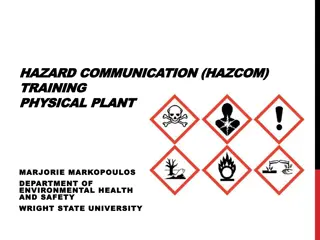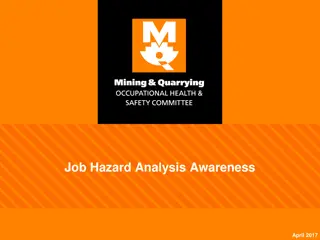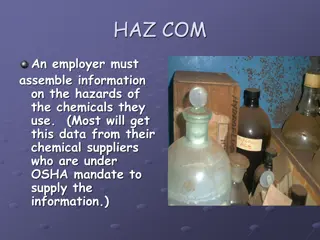Importance of Hazard Communication Training for Workplace Safety
Hazard communication training is essential for creating a safe work environment by helping individuals recognize and manage hazardous materials effectively. Understanding the Globally Harmonized System (GHS) and following hazard communication laws can improve workplace safety, protect human health, and save costs by avoiding fines and incidents. The Hazard Communication Standard of 2012 sets criteria for educating employees on chemical hazards, ensuring proper handling, and preventing harmful exposure. The Globally Harmonized System (GHS) standardizes hazard classification, labeling, and safety data sheets for hazardous chemicals. Maintaining a hazardous materials inventory provides crucial safety information for workplace substances.
Uploaded on Sep 27, 2024 | 0 Views
Download Presentation

Please find below an Image/Link to download the presentation.
The content on the website is provided AS IS for your information and personal use only. It may not be sold, licensed, or shared on other websites without obtaining consent from the author. Download presentation by click this link. If you encounter any issues during the download, it is possible that the publisher has removed the file from their server.
E N D
Presentation Transcript
Why Take Hazard Communication Training? Hazard communication training is essential in creating a safe work environment. By the end of this training program, you will: Know how to recognize and manage the hazardous materials in your work area. Understand the Globally Harmonized System of Classification and Labeling of Chemicals (GHS). Applying this knowledge will improve workplace safety.
Why Take Hazard Communication Training? Laws: Most developed countries have laws regarding the use of hazardous chemicals in the workplace. Many of these laws are based on the Globally Harmonized System of Classification and Labeling of Chemicals (GHS). Magnitude of the chemical industry: Chemicals affect all aspects of life. Having immediately available information on the hazardous properties of chemicals is crucial for protecting human health and the environment. Protecting personnel: Training ensures that employees are informed about the hazards associated with the chemicals they work with and know how to protect themselves. Saving money: Your organization will realize bottom line cost savings when avoiding fines, incidents and injuries.
Criteria for a Hazard Communication Program The Hazard Communication Standard of 2012: Modifies the existing standard. As OSHA explains, not only do employees have the right to know but also the right to understand the hazards of each chemical. Keeps the performance-oriented focus of the old standard, but presents uniform guidelines for the classification and presentation of chemical hazards. Ensures that employees are taught about the hazards associated with their work. Requires employers to train employees in the proper handling of hazardous materials to prevent harmful exposure.
Globally Harmonized System (GHS) GHS GHS will result in three major areas of change: Hazard classification: The definition of a hazardous chemical has been changed to provide specific, uniform criteria for classification of health and physical hazards. Labels: Chemical manufacturers, importers and distributors will be required to provide a label that includes a harmonized signal word, pictogram and hazard statement for each hazard class and category. Precautionary statements must also be provided. Safety Data Sheets: These will now have a specified 16-section format. During the transition period, manufacturers, employers, importers and distributors may comply with the final standard, the current standard or both.
Hazardous Materials Inventory The hazardous materials inventory provides: Safety information about all hazardous substances in the workplace. Chemical identification: The chemical s full name from container labels. The chemical s commonly used name. The product identifier: A unique name or number which can be cross-referenced to the correct SDS so that anyone can easily obtain the chemical information they need. Information about where each hazardous material is used.
Employee Training Training must include (continued): Information sources: Written hazard communication program: This includes a list of chemicals used by the organization. Employees should know the contents and location. Labels: Employees should understand labeling on containers they will encounter. Safety Data Sheets (SDSs): These documents provide important information about hazardous materials in the workplace. Employees should know their contents, structure, order of information and their location.
Employee Training Training must include (continued): Procedures: How to detect the release or presence of a hazardous chemical. Chemical handling procedures that eliminate the risk of harmful exposure. The proper use of controls including engineering controls, signs, emergency procedures and personal protective equipment (PPE) while working with hazardous materials. Proper chemical labeling practices. Your performance will be evaluated to ensure that you are meeting the requirements and that you consider safety a top priority.
Hazardous Materials and Your Body How hazardous substances affect your body: Hazardous materials can create serious health risks. The risks are dependent on the substances used and the duration of exposure. Symptoms vary from short term effects such as headaches or skin irritation to long term effects like organ damage or cancer. The route of entry is how a substance gets into your body. This can happen in one or more of the following ways: Ingestion: Through the digestive tract by swallowing. Absorption: Through the eyes, skin, or mucous membranes. Inhalation: Through the respiratory tract by breathing. Injection: Piercing the skin, involving cuts or needles. The strength of the substance and the quantity that enters the body determine the effect.
Hazard Classification Health hazards: Acute toxicity (any route of exposure) Skin corrosion or irritation Serious eye damage or eye irritation Respiratory or skin sensitization Germ cell mutagenicity Hazard Classification Carcinogenicity Reproductive toxicity Specific target organ toxicity Aspiration hazards A chemical may have more than one hazard classification.
Hazard Classification Physical hazards: Explosives Flammable gases, aerosols, liquids or solids Oxidizers (liquids, solids or gases) Self-reactive chemicals Pyrophoric liquids or solids Self-heating chemicals Includes organic peroxide Corrosive to metal Gases under pressure Chemicals that emit flammable gas while in contact with water Appendix B to 1910.1200 includes the defined physical hazard criteria.
Exposure Controls Personal protective equipment types (continued): Skin protection: Skin protection depends on the hazard. Protection may be required for the whole body or only for the hands. Gloves must be designed for the specific hazardous material. Consider the conditions present, duration of use and potential hazards. If the wrong material is selected the glove will not provide the proper protection. Chemicals may pass through some glove materials or break down the materials, leaving the wearer unprotected.
Exposure Controls Personal protective equipment types (continued): Respiratory protection: If fumes, vapors or particulates are present in the air, some form of respiratory protection may be required. This can range from a simple dust mask to a full-face respirator. You must have a medical evaluation, respirator specific training and a fit test prior to working with a respirator.
Pictograms Pictograms and hazards: GHS developed a series of nine pictograms for use in labeling. It is expected that all existing hazard communication programs will need to be changed in some way to comply with GHS in this area. The pictograms will convey any health, physical and environmental hazards that are assigned to a GHS category.
Pictograms Pictograms and hazards (continued): The health hazard symbol may mean: Carcinogens. Mutagenicity. Reproductive toxicity. Respiratory sensitizers. Target organ toxicity. Aspiration toxicity. An example of a chemical that causes a health hazard is benzene, a common industrial solvent and known carcinogen.
Pictograms Pictograms and hazards (continued): The flame symbol may mean: Flammables. Pyrophorics. Self-heating chemicals. Chemicals that emit flammable gas. Self-reactive chemicals. Organic peroxides. An example of this is xylene, a common component of paint remover and a solvent used in many workplaces. It is a flammable liquid and also creates a vapor that is flammable.
Pictograms Pictograms and hazards (continued): The exclamation mark may mean: Irritants, such as skin or eye irritants. Skin sensitizers. Acute toxicity. Narcotic effects. Respiratory tract irritants. Chemicals hazardous to the ozone layer. (This is a non-mandatory category.) Acetone, a solvent used in various applications including women's cosmetics, is an eye, nose and throat irritant.
Pictograms Pictograms and hazards (continued): The gas cylinder symbol means: Gases under pressure. An example of a chemical stored this way is nitrogen gas, which is used as a shield gas in gas metal arc welding.
Pictograms Pictograms and hazards (continued): The corrosive symbol may mean: Skin corrosion or burns. Eye damage. Corrosion to metals. An example of a corrosive chemical is sodium hypochlorite, a common household bleach; it is corrosive to stainless steel.
Pictograms Pictograms and hazards (continued): The flame over circle symbol means: Oxidizers. Sodium nitrate, a component of some fertilizers and occasionally used as a food preservative, is an oxidizer.
Pictograms Pictograms and hazards (continued): The exploding bomb symbol may mean: Explosives. Self reactives. Organic peroxides. Ammonium nitrate, used as a fertilizer, is an example of a chemical with an explosive hazard.
Pictograms Pictograms and hazards (continued): The skull and crossbones symbol means: Acute toxicity (fatal or toxic). An example of a chemical with acute toxicity is hydrogen sulfide, a natural occurring gas in the earth. It is toxic if inhaled at high concentrations.
Pictograms Pictograms and hazards (continued): The environment symbol means: Aquatic toxicity. Polybrominated diphenyl ether (PBDE), a liquid flame retardant, is an example of aquatic toxicants. PBDE are shown to accumulate in fish fat and cause development issues in marine life.
Container Labeling Labels: By June 1, 2015 all labels of hazardous chemicals must contain the following information: Product identifiers: A unique name or number used for a hazardous chemical that can be cross-referenced between the label, SDS and written hazard communication program. Supplier identification: The name, address and telephone number of the responsible party.
Container Labeling Labels (continued): By June 1, 2015 all labels of hazardous chemicals must contain the following information: Signal words: Used to indicate the severity of the hazard, the signal words are danger or warning. Danger is for more severe hazards. Pictograms: These are symbols that indicate the hazard of the material. The specified signal words and pictograms are found in Appendix C.
Container Labeling Labels (continued): By June 1, 2015 all labels of hazardous chemicals must contain the following information: Hazard statements: Assigned statements that describe the hazard s nature and its degree of severity. For example: Fatal if swallowed. Harmful if inhaled. Toxic in contact with skin. The specified hazard statements are found in Appendix C.
Container Labeling Labels (continued): By June 1, 2015 all labels of hazardous chemicals must contain the following information: Precautionary statements: Phrases describing recommended methods to avoid adverse effects. There are four types: Prevention Response Storage Disposal The specified precautionary statements are found in Appendix C.
Safety Data Sheets SDS sections include: Section 1 Identification: The product identifier used on the label The recommended use and any restriction of use The contact information of the manufacturer, importer or responsible party An emergency phone number Section 2 Hazard identification: The classification of the chemical The signal word, hazard statements and symbols, including pictograms Special hazards, such as not using water in a fire situation
Safety Data Sheets SDS sections include (continued): Section 3 Composition and information on ingredients: The chemical name, common name and synonyms The Chemical Abstract System (CAS) number or the European Commission number (EC) Hazardous ingredients with percentages of each For mixtures (as opposed to substances), the chemical name and exact percentage or concentration of all ingredients classified as health hazards Trade secret protection is available to manufacturers for specific chemicals and for the disclosure of the percentage of the chemicals composing the mixtures on the SDS.
Safety Data Sheets SDS sections include (continued): Section 4 First-aid measures: The correct procedure, which is specific to the method of exposure Acute and delayed symptoms of overexposure The type of medical attention or treatment needed Section 5 Fire-fighting measures: Suitable extinguishing media Specific hazards arising from the chemical
Safety Data Sheets SDS sections include (continued): Section 6 Accidental release measures: Personal precautions and protective equipment Emergency procedures Containment methods Materials for cleanup Section 7 Handling and storage: Safe handling precautions Section 8 Exposure controls and personal protection: Permissible Exposure Limits (PEL) and other exposure limits Appropriate controls, including engineering controls and PPE
Safety Data Sheets SDS sections include (continued): Section 9 Physical and chemical properties: These include the following properties: appearance, odor, melting point, pH, vapor pressure, density and solubility. Section 10 Stability and reactivity: Pyrophoric substances: These spontaneously ignite in air. Oxidizers: These agents oxidize another substance, i.e., force it to give off oxygen, which can make it combustible or flammable. Explosives Polymerization: The substance will react and bond with itself, possibly generating heat. Reactivity: The substance readily reacts and bonds with other chemicals.
Safety Data Sheets SDS sections include (continued): Section 10 Stability and reactivity (continued): Conditions to avoid, such as static discharge, shock or vibration Hazardous decomposition products Section 11 Toxicological information: Description of health effects Routes of exposure Symptoms related to exposure Delayed and immediate effects Toxicity data The chemical s status in the National Toxicology Program Suspected, presumed or known carcinogens
Safety Data Sheets SDS sections include (continued): Section 12 Ecological information: Degradability Bioaccumulative potential Mobility in soil Ecotoxicity, aquatic and terrestrial Other adverse effects Section 13 Disposal considerations: Waste residues Methods of disposing safely Sections 12-15 are not mandatory for products only sold in the US.
Safety Data Sheets SDS sections include (continued): Section 14 Transport information: Proper shipping name Transport hazards Environmental hazards, such as marine pollutants Special precautions with transportation Section 15 Regulatory information: Country and state specific safety health and environmental regulations Section 16 Other information: Date of preparation or last revision of SDS and related documents
Summary Important dates for compliance: Requirement Completion Date December 1, 2013 June 1, 2015 Responsible Party Employers Employees must be trained on new label elements and SDSs. All provisions of the hazard communication final rule must be complied with, except as stated below: Manufacturers Importers Distributors Employers Containers must have GHS compliant label before shipping. Workplace labeling and hazard communication program updated. Additional training for employees on newly identified physical or health hazards completed. December 1, 2015 June 1, 2016 Employers
